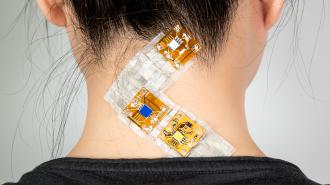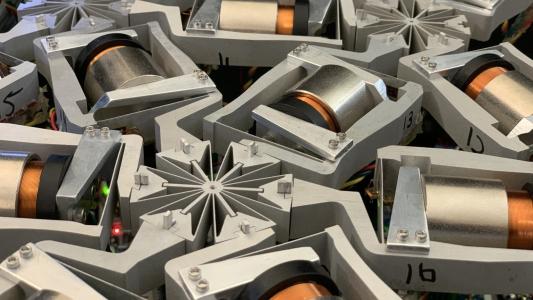What if the computing power of your smartphone could be integrated directly onto your skin? The practically endlessly opportunities of wearable technology are now being explored extensively by materials scientists and electrical engineers alike.
By collecting data directly from users’ bodies, and using it to calculate and display useful information directly onto their skin, some researchers now hope that these devices could soon be applied across a diverse array of everyday tasks: from wearable computers that track your progress in the gym or on a run to smart bandages that provide doctors with real-time information about the condition of their patients.
The challenge: To realize this potential, researchers will first need to develop powerful and durable electrical circuits, which are still comfortable to wear on the skin over long periods. This requires the circuits to be soft, slim, and flexible enough to adapt to the deeply complex, constantly changing shapes of our bodies.
Currently, wearable technologies are not only costly and time-consuming to manufacture, they must also be fabricated as fixed circuits, which can only be used for highly specific applications – limiting their versatility. It’s like needing to build a new phone for every new app prototype.
The smart tattoos feature a flexible silicone-based paper on one side and a pre-programmed circuit module on the other.
Introducing SkinKit: To overcome these challenges, a team of researchers at Cornell University have suggested that wearable circuits could be broken up into several, single purpose modules. These could then be built up, like Lego bricks, to create more complex circuits, suitable for a wider array of tasks.
In a new study, published by the Association for Computing Machinery, a team led by Pin-Sung Ku at Cornell’s Hybrid Body Lab introduced a new “smart tattoo” concept, named SkinKit.
When assembled, a SkinKit “tattoo” features a slim, flexible silicone-based paper that adheres directly to the skin on one side, and to a set of pre-programmed circuit modules on the other. These modules are each made from a slim, flexible circuit board, which are connected up by separate wire modules.
The SkinKit modules are easy to remove and re-attach.
Inside a SkinKit tattoo, the silicone layer not only provides a comfortable barrier between the skin and the device’s circuitry, it also serves as a robust infrastructure for holding complex arrangements of circuit boards in place — even as the user’s skin stretches and contracts.
These unique properties mean that SkinKit designs are highly customizable. While the silicone layer can be cut into any shape required by the user, and even overlaid in complex tessellating patterns, the overlying circuit modules can be placed in any arrangement required by the user.
Even better (and belying their “tattoo” description), these modules are easy to remove and re-attach, meaning they can be readily re-used in different arrangements, as required by the user. This makes them ideal for prototyping new wearable designs.
User assembly: One further challenge taken on by SkinKit tattoos is the need for accessibility – allowing them to be easily assembled by everyday, non-expert users. To test its ease of use, Ku’s team provided 25 ordinary participants, and 9 with a background in STEM fields, with assembly instructions for a series of smart tattoos, each increasing in complexity.
As the researchers hoped, their participants had little trouble building up advanced circuits from the modular building blocks, and could also apply them to different parts of their bodies – including their ankles, hands, and necks.
With SkinKit’s finalized design, the participants could construct a fully-functional smart tattoo from scratch in under 23 minutes, on average. For Ku’s team, this success clearly shows just how accessible and versatile the technology could one day become.
SkinKit could pave the way for an exciting new era of wearable technology.
Everyday use: For now, more research will still be required before SkinKit can be rolled out commercially. Ku and colleagues will aim to gain a better understanding of the durability of the tattoos during long-term use; changes to their performance when they become wet; and the potential difficulties that could occur with integrating thin-film batteries.
If these challenges can be overcome, Ku’s team predict that SkinKit could pave the way for an exciting new era of wearable technology: where devices could assist users in the workplace, lead to new forms of interactive art, and even lead to better assisted living facilities for the elderly and disabled, helping them to live more independent lives.
We’d love to hear from you! If you have a comment about this article or if you have a tip for a future Freethink story, please email us at [email protected].





